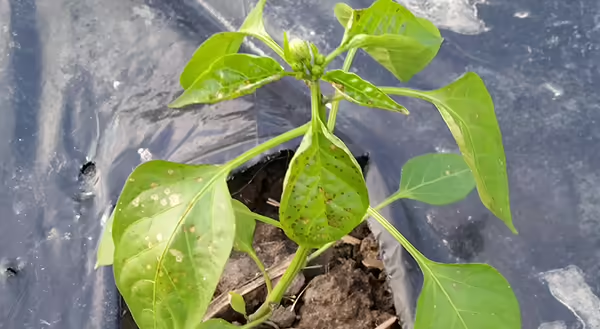
Every summer Extension Pesticide Safety Education Specialists are asked the same type of question repeatedly by home vegetable gardeners. The details leading up the situation at hand vary, but in the end the basic question is the same. Their vegetable plants have accidentally or mistakenly come into contact with a pesticide being applied. They always want to know if their produce is safe to eat.
The University of Illinois does not recommend consuming anything that has been applied with a pesticide which is not labeled for application onto that plant species. This includes situations where pesticide drift is strongly suspected. Products that may be applied to food crops must have established, legal residue tolerance levels of which labeled application rates are then based. Often in the case of pesticide drift, there are no known tolerance levels and even if there were, the application rate would not be known. So it’s impossible to know if the produce would be safe to consume or not. Perhaps it would degrade quickly within the plant. Perhaps it would accumulate in the fruit. It is simply unknown as it hasn’t been tested.
Can garden produce be tested by an independent lab for pesticide residues? Yes, but you would need to know what specific chemical to test for and you would need to locate a lab that is capable of testing for that compound. Also, be prepared to pay a few hundred dollars for each test. Typically, this expense will greatly exceed the value of the garden’s produce. Of course if drift injury if suspected, you can file a formal pesticide misuse/incident complaint with the Illinois Department of Agriculture (IDOA), but it must be received within 30 days of the incident or within 30 days of when the damage was first noticed. Additional information on pesticide uses and misuses can be found on the agency’s website. The Department's role in pesticide misuse incidents is limited to determining whether a violation has occurred. IDOA cannot help complainants recover damages.
I know that herbicide injury on vegetable plants is upsetting. I have found myself in this same situation a few times. If plants are visibly injured near harvest time, it should be a no-brainer not to eat the fruit. It’s better to err on the safe side and avoid consuming anything that is definitely showing injury symptoms or weird growth (twisting, curling, cupping, strapping, leathery leaves, etc.). It gets trickier when drift is suspected but not confirmed early in the growing season but then plants grow completely out of any symptoms by harvest. If there are no injury symptoms, they are likely fine. When a misapplication such as drift occurs, the amount of damage to be expected depends on several things including how much was applied, the susceptibility of the plant species in general, how healthy they were, their growth stage, the weather conditions, etc. Keep in mind, herbicide injury symptoms can easily be confused with symptoms caused by insects, disease, or environmental stress and vice versa. Also, realize that tomatoes and grapes are extremely sensitive to herbicides and can show injury symptoms at ultra-low rates of certain growth regulator herbicides like dicamba and 2,4-D which can travel up to 2 miles from the target site via vapor drift. I live in the country and grow both grapes and tomatoes. Guess what happens just about every summer? Guess what looks completely fine by harvest time? I have a small orchard and a good sized vegetable garden. Our property is surrounded by farm fields. I’m certain that every year, some plants are likely drifted on though they may not show any damage or I may not ever notice it. There are risks with everything and the dose makes the poison. It’s a judgement call that producers and gardeners have to make for themselves.
If the chemical and application dates are known, growers can contact the National Pesticide Information Center (http://npic.orst.edu/) and discuss with their trained toxicologists the risks associated with consuming any affected produce, if affected plants can be salvaged after a certain amount of time has passed, etc. They can help you make an informed decision. They will not give you a simple yes or no answer concerning if your produce is truly safe to eat or not.
Produce is bountiful this time a year. Vegetables can be bought at stores and farmers’ markets. Neighbors will likely happily share their abundance with you. By late season, I’m always so tired of picking the garden and I’m pushing produce on my friends and co-workers. You probably have a friend like me.
For further reading, see the University of Illinois Extension guide on handling pesticide drift complaints. For assistance with identifying possible herbicide injury on landscape plants, check out the publication, "Field Guide to Herbicide Injury on Landscape Plants". Lastly, here is a partial list of laboratories that can perform pesticide residue testing.
ABOUT THE AUTHOR: Michelle Wiesbrook provides subject matter expertise and training in pesticide safety with an emphasis on horticultural weed science. She serves as the Illinois Pesticide Review newsletter editor, collecting and organizing material; and co-coordinates social media information for the PSEP program and ensures its timely publication. Her other interests include herbicide injury and invasive species.